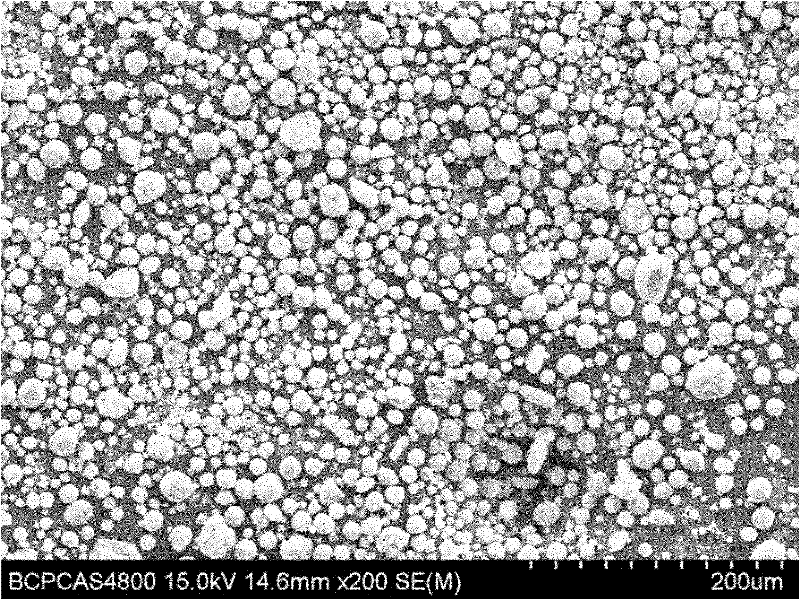Method for preparing lithium iron phosphate material
A lithium iron phosphate and phosphate technology, applied in chemical instruments and methods, phosphorus compounds, inorganic chemistry, etc., can solve the problems of uneven dispersion of conductive agents, affecting the conductivity of positive active materials, etc., and achieve low production costs and synthesis technology. Simple and easy to implement, the effect of uniform particle size and morphology
- Summary
- Abstract
- Description
- Claims
- Application Information
AI Technical Summary
Problems solved by technology
Method used
Image
Examples
Embodiment 1
[0025] The preparation method of lithium iron phosphate material comprises the following steps:
[0026] 1) Accurately weigh (NH 4 ) 3 PO 4 149g (1mol), FeCl 2 126.75g (1mol) and 77.82g (3mol) of LiF were dissolved in 500ml of water respectively, fully dissolved and mixed by magnetic stirring, and prepared into a homogeneous solution without visible crystal particles. Under the action of a mechanical stirring paddle (rotating speed=400 rpm), pour the three prepared solutions into a large round-bottomed flask in turn while stirring, and use phosphoric acid to adjust the pH value to 7.
[0027] Use an oil bath (silicon oil) to heat at 120° C. for 2 h, and simultaneously stir with a mechanical stirrer (rotational speed = 350 rpm) while heating. After the heating is completed, a precipitate (lithium iron phosphate nanoparticle) is formed at the bottom, and the colloidal precipitate is filtered out by vacuum filtration, and washed and filtered repeatedly with water to obtain ...
Embodiment 2
[0033] The preparation method of lithium iron phosphate material, comprises the following steps:
[0034] 1) Accurately weigh (NH 4 ) 3 PO 4 149g (1mol), FeCl 2 126.75g (1mol) and 1.88g (2mol) of LiF were dissolved in 500ml of water respectively, fully dissolved and mixed by magnetic stirring, and prepared into a uniform solution without visible crystal particles. Under the action of a mechanical stirring paddle (rotating speed = 380 rpm), pour the three prepared solutions into a large round-bottomed flask in turn while stirring, and adjust the pH value to 7.5.
[0035] Use an oil bath (silicon oil) to heat at 100° C. for 2 h, and simultaneously stir with a mechanical stirrer (rotational speed = 300 rpm) while heating. After the heating is completed, a precipitate (lithium iron phosphate nanoparticle) is formed at the bottom, and the colloidal precipitate is filtered out by vacuum filtration, and washed and filtered repeatedly with water to obtain lithium iron phosphate ...
Embodiment 3
[0040] The preparation method of lithium iron phosphate material comprises the following steps:
[0041] 1) Accurately weigh (NH 4 ) 3 PO 4 149g, FeCl 2 126.75g, LiF 25.94g (1mol), and then dissolved in 1000ml of water, fully dissolved and mixed by magnetic stirring, and prepared into a uniform solution, and no visible crystal particles were visible. Under the action of a mechanical stirring paddle (rotating speed=400 rpm), pour the three prepared solutions into a large round-bottomed flask successively while stirring, and adjust the pH value to 8. Use an oil bath (silicon oil) to heat at 130° C. for 1 h, while heating, use a mechanical stirrer (rotational speed = 400 rpm) to carry out simultaneous stirring. After the heating is completed, a precipitate (lithium iron phosphate nanoparticle) is formed at the bottom, and the colloidal precipitate is filtered out by vacuum filtration, and washed and filtered repeatedly with water to obtain lithium iron phosphate micropartic...
PUM
 Login to View More
Login to View More Abstract
Description
Claims
Application Information
 Login to View More
Login to View More - R&D
- Intellectual Property
- Life Sciences
- Materials
- Tech Scout
- Unparalleled Data Quality
- Higher Quality Content
- 60% Fewer Hallucinations
Browse by: Latest US Patents, China's latest patents, Technical Efficacy Thesaurus, Application Domain, Technology Topic, Popular Technical Reports.
© 2025 PatSnap. All rights reserved.Legal|Privacy policy|Modern Slavery Act Transparency Statement|Sitemap|About US| Contact US: help@patsnap.com



